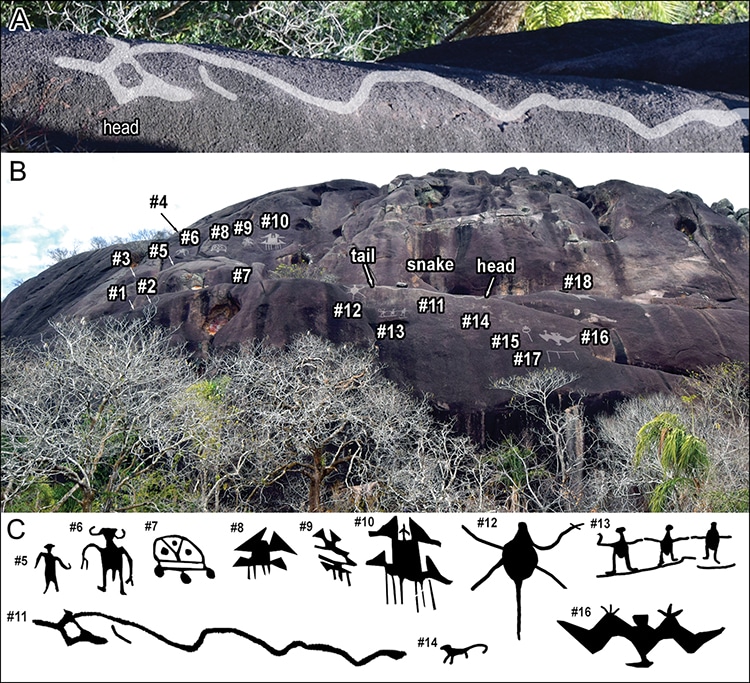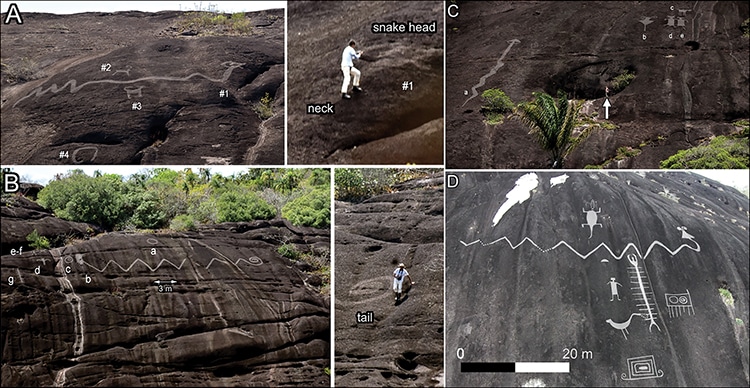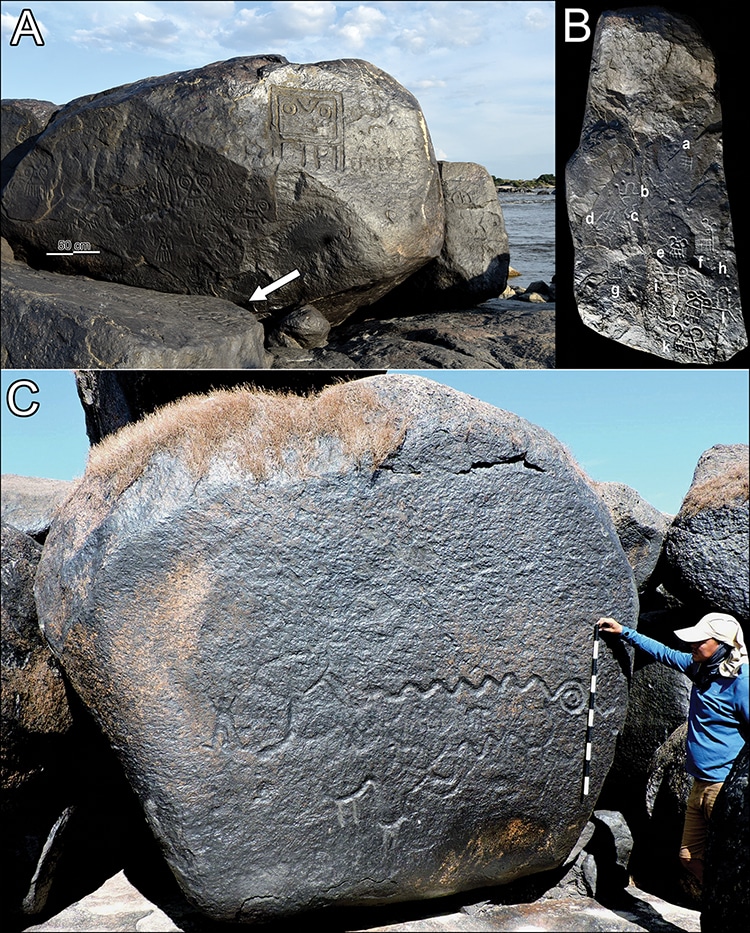
Snakes and other figures engraved at Cerro Dagua. (Photo: Riris et al., CC BY 4.0)
Humans have been representing the world around us in artistic creations for countless millennia. From cave paintings to ancient bone carvings, the meanings of ancient art are only sometimes truly intelligible to modern minds. Archeologists devote countless hours to uncovering, documenting, and interpreting ancient art. Among the more recent papers to interpret ancient South American artwork was published in Antiquity. A team of archeologists sought out the long-rumored rock art engravings of the Middle and Upper Orinoco River in Colombia and Venezuela. Their findings shed light on the the sheer amount of carvings and the impressive size of certain monumental snakes.
Along the winding, ancient river the archeologists searched in quest of carvings which had been known by locals and the subject of rumors for hundreds of years. Using drones, photography, and their own climbing ability, the archeologist authors of the recent paper documented 157 sites of rock art, noting there are likely thousands more out there.
Carved into the rock were insects, alligators, geometric motifs, stingrays, birds, and human or humanoid figures. Sixty of the engravings stretched an impressive 30 feet or more. The team has dubbed these engravings as monumental. “Anything that size is monumental in our view,” Philip Riris, an archeologist at Bournemouth University and the study’s lead author, told New Scientist. “That means they’re often visible from quite far away, maybe 500 meters [1,640 feet] to a kilometer [3,280 feet].” The large examples include—among a startling amount of snakes—a massive 130-foot-long serpent etched into the rock.
Who carved these pictographs, when and why? According to the dating of deposits of pottery with similar designs, the engravings are likely about 2,000 years old. They may have been carved by Indigenous Piaroa artists or others from nearby tribes. The Piaroa, like others in the region, have ancient beliefs about snakes. The anaconda Cuämoi figures prominently, and his daughter Cuähuais believed to have created rock art along the Orinoco River. In cosmology’s throughout South America, snakes can be associated with rivers, creation myths, and spirtitual journeys.
Why the reliefs were carved is uncertain. However, the authors noted that many were at the ancient river level around the time of carving. Given the size of the monumental figures, they’d be quite visible from afar. This visibility, the authors postulate, is the purpose.
“Further characterization of the range of variation within monumental sites will help to clarify how they were used and perceived, including in sites located further away from the Orinoco River that lack snakes, such as Cerro Humeante,” they write. If areas with more homogeneous populations lack these monumental artworks, “this would serve to affirm their role as markers of group identity along contested and variously negotiated stretches of the Orinoco River,” they conclude.
The team hopes to engage with the local Indigenous people whose knowledge of the region is unparalleled to continue to deepen understanding of these artistic sign posts along the historic river.
Archeologists have documented ample cliff and rock engravings along the Orinoco River in South America, some of which are monumental in size.

The monumental snake engravings at different sites. (Photo: Riris et al., CC BY 4.0)
Chief among these motifs is a winding snake, although humans, insects, and geometric designs appear.

Non-monumental motifs that also appear at monumental sites: A) anthropomorphic mask motif (known as ‘the television’) at Raudal Mesetas, see also Cerro Pintado and Caño Grulla (Figure 2F & K); B) flat boulder alongside A (arrow) with stylised anthropomorphic and double scroll motifs; C) snake, bird and human motifs at Raudal Palomazón. Note size of the snake relative to other motifs (figure by authors). (Photo: Riris et al., CC BY 4.0)
h/t: [Smithsonian Magazine]
Related Articles:
16-Million-Year-Old Skull of Extinct Species of Giant Dolphin Discovered in Peru
Gardener Discovers Rock With Ancient Irish Writing System in His Yard
Ancient Rock Art Depicts Psychedelic Music and Dance in Peru
New Well-Preserved Paintings Discovered at Pompeii Amid Ongoing Excavations
